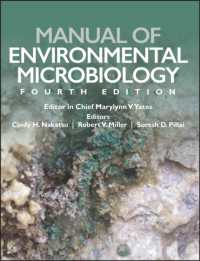Full Description
This Handbook explores and critiques a new sonic reality - one which unearths new narratives that chart embryonic practices from the early twentieth century that have developed in parallel with accepted narratives of electronic music.
Today's musical and artistic practices within technology-based music represent radical changes in production, engagement and dissemination of all sonic arts for composers, musicians, listeners, media content creators and casual music users. Constant everyday exposure to electronic or processed sounds influences our listening skills and listening intentionality, and our ideas of what constitutes valuable sound experiences have expanded radically. What are we listening to? How and why? This new reality is also more inclusive, and technology-borne music now appears as the new folk music - unwritten, improvised and finding its own relevance unfettered by the traditional hierarchies of taste. It is also where black and Asian technology-based experimental music is emerging with its own sonic genealogy, where music is no longer limited to sound only but can be more fruitfully seen as a branch of media arts, combining diverse materials, techniques and tools into more holistic experiences.
Contents
Preface. JØRAN RUDI, MONTY ADKINS Introduction: Re-Framing and Re-Thinking. JØRAN RUDI, MONTY ADKINS
Part 1: Technology Adoption and New Practices 1. The Irrational Roots of Electronic Music. SIMON CRAB 2. Tracing Music Technology to its Interdisciplinary Roots. JOSEPH HYDE 3. Ernest Berk: Piraparana. MONTY ADKINS, SAM GILLES, IAN HELLIWELL 4. Antinomies of Net/Satellite Communication: Strategies of Musical Interaction. ARILD OVE BOMAN 5. Continuities and discontinuities in thought, infrastructure and organisation in UK 'electroacoustic' music since 1975: observations, entanglements and reasons for optimism. SIMON WATERS 6. Networked Performance as a Space for Collective Creation and Student Engagement. HANS KRETZ 7. The memory of a Ping - Environmental Sonification as a Transversal Practice. ÅSA STJERNA
Part 2: Participation and Agency 8. The expanding Fields and Practices of Technology-based Music. ULF A. S. HOLBROOK, JØRAN RUDI 9. Dynamic Sound Design as (co-)compositional method in creative music. MATT WRIGHT 10. A Closer Listening. LOUISE GRAY 11. Technology as Noise. PAUL HEGARTY 12. The Noise Selector. AMIT DINESH PATEL 13. Expanding the scope: Presence, Visibility and Interpretation. CATHY LANE 14. Following female users: A Feminist Historiography of the Fairlight CMI. MANUELLA BLACKBURN, PAUL HARKINS 15. Sonic Alterities: Reimagining Histories and Technologies in Sound Art. LINDA O KEEFFE 16. Japanese Sound Performance as Conceptual Representation. MIKAKO MISUNO 17. Whose post-acousmatic colonial future? The South African post-acousmatic. CAMERON HARRIS 18. Technologies of Capture and the Global Souths. BUDHADITYA CHATTOPADHYAY
Part 3: Instruments and Software 19. Electricity, People and Cultures. Another piece of history of the Theremin musical artifact. JOHANN MERRICH 20. Issues of Ubimus Archaeology: Feedback Amplitude Modulation. NEMANJA RADIVOJEVIĆ, DAMIAN KELLER, VICTOR LAZZARINI 21. Upsetting the Controls: Considering Controllerist Practice in Computer Music Performance. MANOLI MORIATY 22. Max - Expansion from a Programming Paradigm to a Distributed Lab. JAEHOON CHOI 23. Where did all this come from? Tracing Electronic Music's U.N.I.T.Y. through Electroacoustic and Hip Hop Production. MARGARET SCHEDEL, WENDEL PATRICK 24. Turntablism. MARIAM REZAEI






